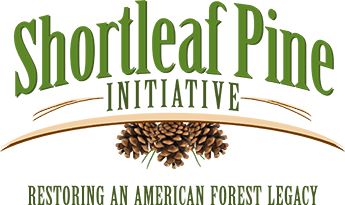|
Shortleaf research, newspaper articles, fact sheets, conference proceedings, literature reviews, and brochures.
Shortleaf Pine Changes in Organic Matter And Nutrients in Forest Floor After Applying Several Reproductive Cutting Methods in Shortleaf Pine-Hardwood Stands
Changes in Organic Matter And Nutrients in Forest Floor After Applying Several Reproductive Cutting Methods in Shortleaf Pine-Hardwood Stands
Liechty, H. O., & Shelton, M. G. (2004). Changes in Organic Matter And Nutrients in Forest Floor After Applying Several Reproductive Cutting Methods in Shortleaf Pine-Hardwood Stands. Southern Research Station, General Technical Report SRS-74. Retrieved from https://www.srs.fs.usda.gov/pubs/gtr/gtr_srs074/gtr_srs074-liechty001.pdf  Chromosomal locations of the ribosomal DNA genes in shortleaf pine
Chromosomal locations of the ribosomal DNA genes in shortleaf pine
Islam-Faridi, N., Majid, M. A., & Nelson, C. D. (2007). Chromosomal locations of the ribosomal DNA genes in shortleaf pine. Shortleaf pine restoration and ecology in the Ozarks: proceedings of a symposium; 2006 November 7-9; Springfield, MO. Northern Research Station, General Technical Report NRS-P-15. Retrieved from https://www.nrs.fs.fed.us/pubs/gtr/gtr_p-15%20papers/14islam-faridi-p-15.pdf Grayson, K. J., Wittwer, R. F., & Shelton, M. G. (2002). Cone characteristics and seed quality 10 years after an uneven-aged regeneration cut in shortleaf pine stands. Southern Research Station, General Technical Report SRS-48. Retrieved from http://www.srs.fs.usda.gov/pubs/viewpub.php?index=3140  Contrasting the effects of organic matter removal and soil compaction on root biomass of 9-year-old red oak, white oak, and shortleaf pine in a Missouri Ozark forest
Contrasting the effects of organic matter removal and soil compaction on root biomass of 9-year-old red oak, white oak, and shortleaf pine in a Missouri Ozark forest
Ponder Jr, F. (2011). Contrasting the effects of organic matter removal and soil compaction on root biomass of 9-year-old red oak, white oak, and shortleaf pine in a Missouri Ozark forest. Proceedings, 17th central hardwood forest conference; 2010 April 5-7; Lexington, KY; Gen. Tech. Rep. NRS-P-78. Newtown Square, PA: U.S. Department of Agriculture, Forest Service, Northern Research Station: 323-331. Retrieved from https://www.nrs.fs.fed.us/pubs/gtr/gtr-p-78papers/34ponderp78.pdf  Cubic-Foot Volume Tables for Shortleaf Pine in the Virginia-Carolina Piedmont
Cubic-Foot Volume Tables for Shortleaf Pine in the Virginia-Carolina Piedmont
Haney, G. P., & Kormanik, P. P. (1962). Cubic-Foot Volume Tables for Shortleaf Pine in the Virginia-Carolina Piedmont. Southeastern Forest Experiment Station, Research Notes 170. Retrieved from https://www.srs.fs.usda.gov/pubs/osn/osn_se170.pdf Hallgren, S., Tauer, C., & Weeks, D. (1993). Cultural, environmental, and genetic factors interact to affect performance of planted shortleaf pine. Forest science, 39(3), 478-498. Retrieved from http://www.ingentaconnect.com/content/saf/fs/1993/00000039/00000003/art00007  Dense undergrowth reduces feller-buncher productivity in shortleaf pine plantations
Dense undergrowth reduces feller-buncher productivity in shortleaf pine plantations
Granskog, J. E., & Anderson, W. C. (1981). Dense undergrowth reduces feller-buncher productivity in shortleaf pine plantations. Southern Forest Experiment Station, Research Note SO-274. Retrieved from https://www.srs.fs.usda.gov/pubs/rn/rn_so274.pdf Budhathoki, C. B., Lynch, T. B., & Guldin, J. M. (2010). Development of a shortleaf pine individual-tree growth equation using non-linear mixed modeling techniques. General Technical Report-Southern Research Station, USDA Forest Service(SRS-121), 519-520. Retrieved from https://www.fs.usda.gov/treesearch/pubs/35933  Diameter--growth model across shortleaf pine range using regression tree analysis
Diameter--growth model across shortleaf pine range using regression tree analysis
Yaussy, D., Iverson, L., & Prasad, A. (1997). Diameter--growth model across shortleaf pine range using regression tree analysis. Empirical and process-based models for forest tree and stand growth simulation, 21, 27. Retrieved from https://www.nrs.fs.fed.us/pubs/jrnl/1999/ne_1999_yaussy_001.pdf Studyvin, C., & Gwaze, D. (2012). Differences among shortleaf pine seed sources on the Ozark and Ouachita National Forests at age ten. Proceedings of the 16th biennial southern silvicultural research conference. e-Gen. Tech. Rep. SRS-156. Asheville, NC: U.S. Department of Agriculture Forest Service, Southern Research Station. 329-333. Retrieved from http://www.treesearch.fs.fed.us/pubs/41519 |

